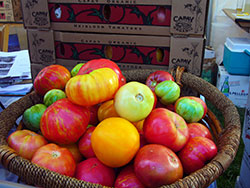Charleen Barr
Colorado State University Extension Master Gardener in Larimer County
May 30, 2015

Planting seeds has been a human activity for thousands of years. Seed was saved and replanted again the following year. Over several generations, plants were selected for certain traits. Our edible broccoli, for example, became different from the tough, wild plants that are its ancestor.
The scientific definition of an heirloom is an open-pollinated variety—meaning the flower is pollinated by insects, hummingbirds or wind with pollen from another plant to create fruit true-to-type. Growers can save seed from their crop and sow again in following years and the plants will produce fruit with the same characteristics and quality of the parent. The seeds are often passed down so they become ‘heirlooms’.
Today, heirlooms are considered as those seeds that have been around for over 50 years. Seeds create a legacy. Heirloom gardening enables us to collect a part of history that represents valued possessions and cultural differences.
What is commonly understood is that heirloom varieties have a history, have been kept in a family or achieved a measure of local or regional fame. Many types of seeds are immigrants—cherished varieties that can be specifically tied to a group of people and were brought to America by early settlers. The preservation of these seeds was not particularly sentimental, but they became time-tested varieties that found approval. Think of an heirloom seed like a family heirloom passed down from generation to generation.
Some gardeners focus on varieties before the 1920s, and others re-create World War II Victory Gardens with introductions from the 1920s, 30s and early 40s. Many varieties are up to 150 years old and some are traditional Native American crops that are pre-Columbian. Others are old European crops in cultivation for over 400 years.
Heirloom vegetables, fruits, flowers and herbs are varieties that are open-pollinated represent a vast and diverse pool of genetic characteristics. They have remained popular with home gardeners because they grow well and have depth of flavor. They do not keep well during shipping or storage and many of them do not have consistent appearance. The harvest of heirloom vegetables are spread over a longer period of time rather than bumper crops all at one time.
Some heirlooms may be less productive in quantity, but they are adaptable to their environment within two to three growing seasons. During this time period they show better vigor, production, flavor and an increase in disease resistance. They offer a wide range of shapes, colors and tastes unavailable in modern cultivars.
Famous easy heirlooms to grow:
- ‘Brandywine’ tomato (1886 – originally may have been named ‘Turner’s Hybrid’ and renamed ‘Brandywine’ in 1889)
- ‘Early Horn’ or ‘Early Scarlet Horn’ carrots (1620 – one of the oldest vegetable varieties still in cultivation)
- ‘French Breakfast’ radish (1885 – a favorite of French market gardeners)
- ‘Hubbard’, ‘Blue Hubbard’ and ‘Warted Hubbard’ squash (1798 in the West Indies – In 1842 Mrs. Elizabeth Hubbard of Massachusetts brought the squash seeds to a neighbor James Gregory who named the variety for her.)
- ‘Jenny Lind’ Melon (1845 – served as parent of numerous popular varieties)
- ‘Kentucky Wonder’ beans (1864 – Originally named Old Homestead)
- ‘Paris White Cos’ lettuce (1835 – initially grown in Europe, made its way to US in 1864)
- “Early Jersey Wakefield” cabbage (1840 – originally named early Wakefield. Julius Caesar’s troops carried cabbage with them to Britain when they invaded in 55 B.C. In 1541 cabbages made their way into Canada with the French explorer Jacques Cartier. The plant became a food staple for Jamestown and Williamsburg settlers.)
- Hollyhocks (Althea rosea) were a common plant in colonial gardens. They are associated with farmsteads and common outbuildings with the unflattering name of “outhouse” flower. These flowers helped the ladies of the 19th century discover the location of the outhouse by just looking for the hollyhocks.
- Cornflowers or bachelor buttons are perfect for Front Range soils, drought tolerant and informal gardens.
- Cosmos were introduced to Britain from their native Mexico in 1799. It is often referred to as the Mexican aster.
- Golden Bantam’ corn (1902 – first yellow “table” corn; yellow was considered field corn)
- Larkspur is native to southern Europe and Mediterranean area and was introduced to America in 1572.
- Morning glory (Ipomoea purpurea) were from Italy and Spain and the British in 1651.
- Nasturtiums have a culinary history and eaten in the 17th and 18th century as vegetables.
- Pinks are the common name for Dianthus barbatus. There are more than 300 varieties that have been cultivated for at least 2,000 years.
- Sweet peas have been available commercially since 1714 and cultivated in England and Holland.
Additional seed and seed history information:
Seed Savers Exchange, 3094 North Winn Road, Decorah, Iowa 52101, (513)354-1492,.
Baker Creek Heirloom Seeds, 2278 Baker Creek Road, Mansfield, MO 65704, (417)924-8917.
Seeds of Change 1 Sunset Way, Henderson, NV. 89014, (888)762-7333
Thomas Jefferson Center for Historic Plants, P.O. Box 316, Charlottesville, VA 22902
Plants of the Southwest 3095 Aqua Fria Road, Santa Fe, NM 87507 (800)788-7333
The author has received training through Colorado State University Extension’s Master Gardener program and is a Master Gardener volunteer for Larimer County.
——————-
Larimer County is a county-based outreach of Colorado State University Extension providing information you can trust to deal with current issues in agriculture, horticulture, nutrition and food safety, 4-H, small acreage, money management and parenting. For more information about CSU Extension in Larimer County, call (970) 498-6000 or visit www.larimer.org/ext
——————-
Looking for additional gardening information? Check out the CSU Extension Horticulture Agent blog at www.csuhort.blogspot.com for timely updates about gardening around the state.
——————-
Visit PlantTalk Colorado ™ for fast answers to your gardening questions! www.planttalk.org PlantTalk is a cooperation between Colorado State University Extension, GreenCo and Denver Botanic Gardens.





